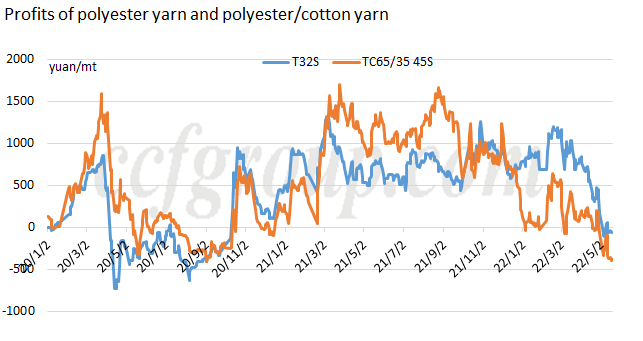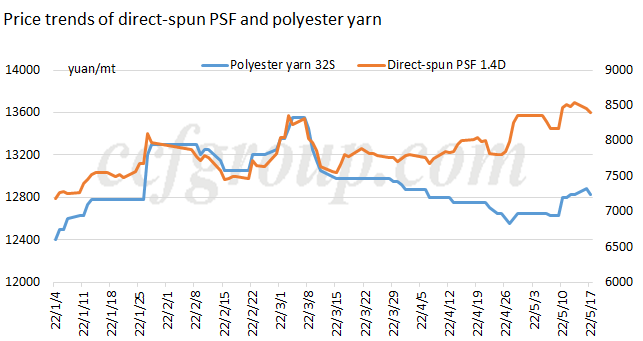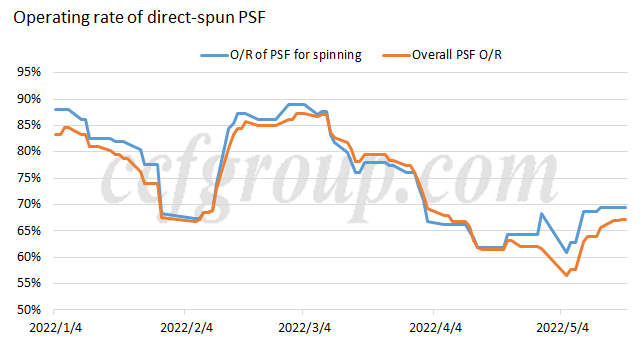Polyester yarn kept profitable though polyester feedstock and PSF have experienced several ups and downs since the beginning of 2022. However, the situation changed from May. Both polyester yarn and polyester/cotton yarn were stuck into losses amid the surge of raw materials. Surrounded by strong cost and soft demand, how long will the losses of polyester yarn last?

1. The profits are divided along the industrial chain under mismatching of supply and demand
In mid-May, the sudden outbreak of Covid-19 pandemic in Jiangyin caused tight supply of PSF, spurring PSF price to rocket. Later on, gasoline consumption of the US spiked and strengthened aromatics products, inducing the rise of PX amid decline of crude oil. As a result, PSF again climbed up. In short run, US demand for aromatics is robust and PX will keep relatively firm, which will help PSF stay high.
The weakness of polyester yarn started to spread from mid-Mar. The prices of PSF and polyester yarn showed scissors-shaped trends with PSF rising yet polyester yarn dropping, so the profit of polyester yarn gradually moved into negative side. Overall, from crude oil to downstream yarns and fabrics, the further downstream it is, the harder it is to raise prices. In short term, the situation of strong upstream and weak downstream will not change much.

2. PSF operating rate is improving and the supply pressure gets eased.
PSF operating rate started to decline under losses from Mar, and reached the lowest when the pandemic broke out in Jiangyin. At that time, some spinners in northern China cut production due to lack of raw materials. Then it gradually recovered and by end-May and early Jun, PSF supply will soar with Huahong to restart its 560kt/yr unit, Xinfengming to put a new line into operation and Yida to restart 200kt/yr unit in early Jun. By then, PSF market will be burdened by excessive supply and PSF spread is likely to be contracted again.

3. Processing fee of polyester yarn moves to low amid sustained bearish demand.
End-user demand faces high pressure in May-Jun. In terms of export, despite alleviation of the pandemic in China, the supply chain is still stagnated and orders are canceled occasionally. The export businesses are mostly concentrated in the first half year and the missing time and orders cannot return. In addition, the exports of Southeast Asian countries grow at a high speed. In Apr, Bangladesh apparel export value totaled 3.93 billion USD, up 56.3% on the year and Vietnam textile and apparel export value totaled 3.15 billion USD, up 26.8% on the year, while China textile and apparel export value reached 12.26 billion USD and 11.33 billion USD respectively, up only 0.93% and 2.39% on the year.
As for China local demand, with the pandemic in Shanghai and Jiangsu controlled, market participants are anticipating the rebound of consumption, but it should be cautious. Apr China retail sales value of consumer goods moved down 11.1% year on year, urban unemployment rate increased to 6.1% and youth unemployment reached 18%. May and Jun are traditional slack season for textile market, and spinners and weavers suffer high inventory and capital tightness due to previous overstock of spring apparel caused by the pandemic. At present, spinners do not plan to cut production, and on the other hand, the production shifts from blended yarn to polyester yarn, and from cotton yarn to polyester/cotton yarn still exist, which will increase the supply of polyester yarn and polyester/cotton yarn. Therefore, polyester yarn is likely to see normalization of low processing fee in short term.
Post time: Jun-16-2022

